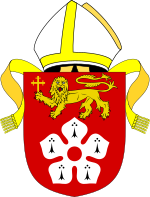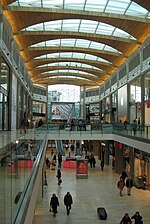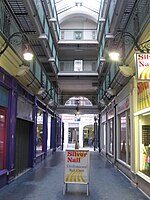Exhumation and reburial of Richard III of England

The remains of Richard III, the last English king killed in battle, were discovered within the site of the former Grey Friars Priory in Leicester, England, in September 2012. Following extensive anthropological and genetic testing, the remains were ultimately reinterred at Leicester Cathedral on 26 March 2015. Richard III, the final ruler of the Plantagenet dynasty, was killed on 22 August 1485 in the Battle of Bosworth Field, the last significant battle of the Wars of the Roses. His body was taken to Greyfriars, Leicester, where it was buried in a crude grave in the friary church. Following the friary's dissolution in 1538 and subsequent demolition, Richard's tomb was lost. An erroneous account arose that Richard's bones had been thrown into the River Soar at the nearby Bow Bridge. A search for Richard's body began in August 2012, initiated by Philippa Langley and the Looking for Richard project with the support of the Richard III Society. The archaeological excavation was led by the University of Leicester Archaeological Services, working in partnership with Leicester City Council. On the first day a human skeleton belonging to a man in his thirties was uncovered showing signs of severe injuries. The skeleton, which had several unusual physical features, most notably scoliosis, a severe curvature of the back, was exhumed to allow scientific analysis. Examination showed that the man had probably been killed either by a blow from a large bladed weapon, probably a halberd, which cut off the back of his skull and exposed the brain, or by a sword thrust that penetrated all the way through the brain. Other wounds on the skeleton had probably occurred after death as "humiliation injuries", inflicted as a form of posthumous revenge. The age of the bones at death matched that of Richard when he was killed; they were dated to about the period of his death and were mostly consistent with physical descriptions of the king. Preliminary DNA analysis showed that mitochondrial DNA extracted from the bones matched that of two matrilineal descendants, one 17th-generation and the other 19th-generation, of Richard's sister Anne of York. Taking these findings into account along with other historical, scientific and archaeological evidence, the University of Leicester announced on 4 February 2013 that it had concluded beyond reasonable doubt that the skeleton was that of Richard III. As a condition of being allowed to disinter the skeleton, the archaeologists agreed that, if Richard were found, his remains would be reburied in Leicester Cathedral. A controversy arose as to whether an alternative reburial site, York Minster or Westminster Abbey, would be more suitable. A legal challenge confirmed there were no public law grounds for the courts to be involved in that decision. Reinterment took place in Leicester on 26 March 2015, during a televised memorial service held in the presence of the Archbishop of Canterbury and senior members of other Christian denominations.
Excerpt from the Wikipedia article Exhumation and reburial of Richard III of England (License: CC BY-SA 3.0, Authors, Images).Exhumation and reburial of Richard III of England
New Street, Leicester Bede Island
Geographical coordinates (GPS) Address Nearby Places Show on map
Geographical coordinates (GPS)
| Latitude | Longitude |
|---|---|
| N 52.634025 ° | E -1.136295 ° |
Address
Greyfriars Car Park
New Street
LE1 5NA Leicester, Bede Island
England, United Kingdom
Open on Google Maps











